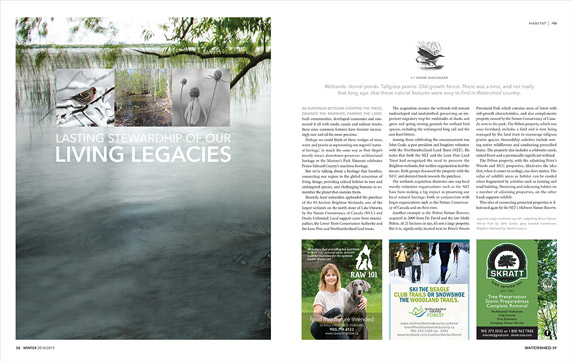
Wetlands. Vernal ponds. Tallgrass prairie. Old growth forest. There was a time, and not really that long ago, that these natural features were easy to find in Watershed country.
AS EUROPEAN SETTLERS CHOPPED THE TREES, DRAINED THE MARSHES, FARMED THE LAND, built communities, developed economies and connected it all with roads, canals and railway tracks, these once common features have become increasingly rare and all the more precious.
Perhaps we could think of these vestiges of trees, water and prairie as representing our region’s ‘natural heritage,’ in much the same way as Port Hope’s mostly-intact downtown preserves architectural heritage or the Mariner’s Park Museum celebrates Prince Edward County’s maritime heritage.
But we’re talking about a heritage that breathes, connecting our region to the global ecosystem of living things, providing critical habitat to rare and endangered species, and challenging humans to remember the planet that sustains them.
Recently, local naturalists applauded the purchase of the 93-hectare Brighton Wetlands, one of the largest wetlands on the north shore of Lake Ontario, by the Nature Conservancy of Canada (NCC) and Ducks Unlimited. Local support came from municipalities, the Lower Trent Conservation Authority and the Lone Pine and Northumberland land trusts.
The acquisition ensures the wetlands will remain undeveloped and undisturbed, preserving an important migratory stop for multitudes of ducks and geese and spring nesting grounds for wetland bird species, including the endangered king rail and the rare least bittern.
Among those celebrating the announcement was John Geale, a past president and longtime volunteer with the Northumberland Land Trust (NLT). He notes that both the NLT and the Lone Pine Land Trust had recognized the need to preserve the Brighton wetlands, but neither organization had the means. Both groups discussed the property with the NCC and donated funds towards the purchase.
The wetlands acquisition illustrates one way local mostly-volunteer organizations such as the NLT have been making a big impact in preserving our local natural heritage, both in conjunction with larger organizations such as the Nature Conservancy of Canada and on their own.
Another example is the Pelton Nature Reserve, acquired in 2009 from Dr. David and the late Molly Pelton. At 21 hectares in size, it’s not a large property. But it is, significantly, located next to Peter’s Woods Provincial Park which contains areas of forest with old-growth characteristics, and also complements property owned by the Nature Conservancy of Canada next to the park. The Pelton property, which was once farmland, includes a field and is now being managed by the land trust to encourage tallgrass prairie species. Stewardship activities include sowing native wildflowers and conducting prescribed burns. The property also includes a coldwater creek, mixed forest and a provincially-significant wetland.
The Pelton property, with the adjoining Peter’s Woods and NCC properties, illustrates the idea that, when it comes to ecology, size does matter. The value of wildlife areas as habitat can be eroded when fragmented by activities such as farming and road building. Preserving and enhancing habitat on a number of adjoining properties, on the other hand, supports wildlife.
This idea of connecting protected properties is illustrated again by the NLT’s McEwen Nature Reserve. The 40-hectare property includes a drumlin, a wetland, a pond, forest and retired farmland. It was originally acquired by the Nature Conservancy of Canada, which transferred it to the Northumberland Land Trust in 2008. It’s popular with birders, who have recorded 92 species including at least 22 breeding on the property. One reason for the bird abundance is the adjacent Ganaraska Forest, nearly 4,500 hectares in size. The details of who owns the land is of no interest to wildlife, as long as their habitat remains available and unfragmented.
Although size matters with natural systems, small can still be significant. Such is the case with the recently acquired Chub Point Nature Reserve, near Grafton. Although just seven hectares, Chub Point combines woodlands and wetlands that provide valuable vernal, or seasonal, pools that offer habitat required by amphibian species such as wood frogs.
Some of our area’s best natural features are located on private pieces of property whose owners deeply understand their value. One option for private land owners who would like to see those natural values protected for posterity is to donate their lands to a land trust.
Through the federal Ecological Gifts Program a donor can receive a tax receipt equal to the value of the land, if it meets the program’s criteria for preserving important natural features. A good example is the Northumberland Land Trust’s most recent acquisition, the 14-hectare Jack van Nostrand Nature Reserve. Donated by John and Kate van Nostrand and located near Grafton, the property includes a provincially-significant wetland and 400 metres of untouched Lake Ontario shoreline.
The Ecological Gifts Program can also provide landowners with a tax receipt for a portion of the value of a conservation easement. The Northumberland Land Trust is the trustee of one of these properties as well, specifically the 72-hectare Leckey Nature Reserve in Cramahe Township. In the case of a conservation easement, the property can continue to be bought and sold by private landowners. However, the easement protects the natural features of the property, which are monitored by an organization – in this case the Northumberland Land Trust.
Protecting natural features is good for ecological health, and can make for great science. The first property acquired by the Northumberland Land Trust, the Cobourg/Port Hope area Laurie Lawson Outdoor Education Centre, features dozens of vernal pools. These pools were recently studied by students from Trent University who were evaluating the property as potential habitat for salamanders amphibians which are increasingly hard to find as lands are developed. “It should make for great salamander habitat,” comments John Geale of the Laurie Lawson property.
However, in their study of 116 vernal pools, the students found not a single salamander. This may be due to the fact that all the lands around the Laurie Lawson property are farmed. Now the Northumberland Land Trust is looking into the possibility of reintroducing salamanders – providing the opportunity for more good science in the future.
The Northumberland Land Trust shows the possibilities available with a limited budget – the organization employs only a part-time bookkeeper, and a small number of volunteers with a big dedication to preserving natural spaces.
It shares that mission in our region with the Lone Pine Land Trust, the Hastings Prince Edward Land Trust, the Kawartha Land Trust and the Oak Ridges Moraine Land Trust. These local land trusts, which range from volunteer-run groups to fully-staffed organizations, are in turn part of the Ontario Land Trust Alliance, whose members protect more than 34,000 hectares of significant natural lands and wildlife habitat. That’s an impressive amount with more to come as local land trusts, landowners and much larger partners such as the Nature Conservancy of Canada discuss how they can continue to make lasting contributions to a living legacy.
Story by:
Norm Wagenaar




